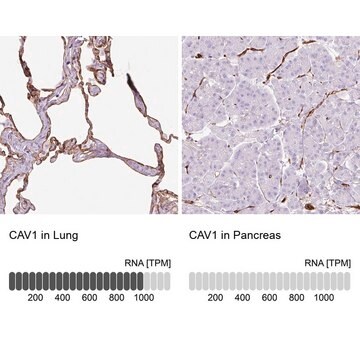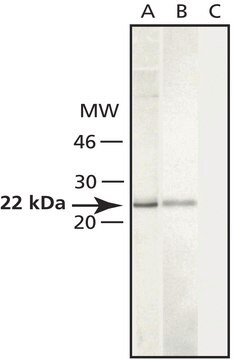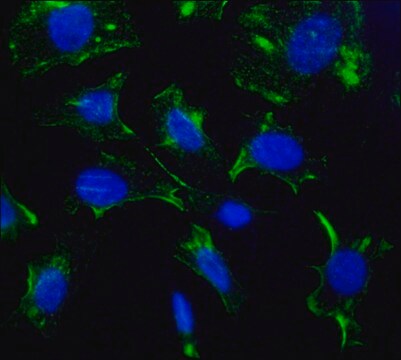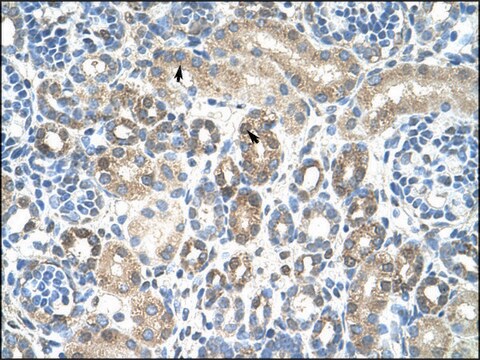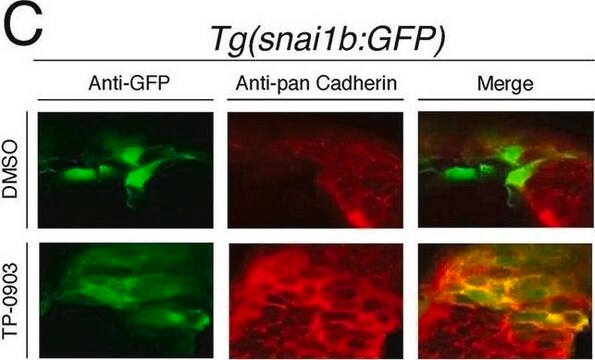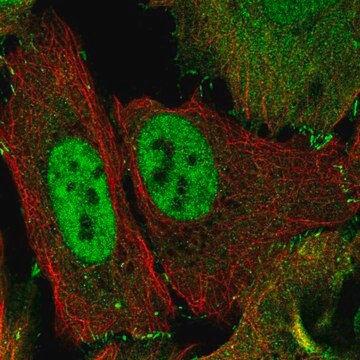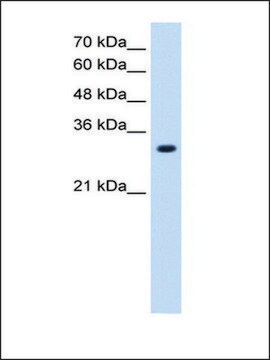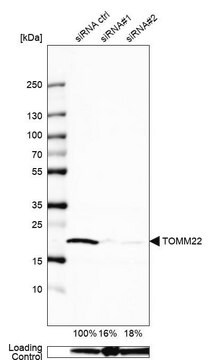추천 제품
생물학적 소스
rabbit
결합
unconjugated
항체 형태
IgG fraction of antiserum
항체 생산 유형
primary antibodies
클론
polyclonal
양식
buffered aqueous solution
분자량
antigen 22 kDa
종 반응성
human, rat, mouse
향상된 검증
independent
Learn more about Antibody Enhanced Validation
기술
indirect immunofluorescence: 1:500 using mouse fibroblast NIH3T3 cell line
microarray: suitable
western blot: 1:2,000 using whole cell extract of the human umbilical vein endothelial HUVEC cell line and the rat fibroblast Rat-1 cell line
UniProt 수납 번호
배송 상태
dry ice
저장 온도
−20°C
타겟 번역 후 변형
unmodified
유전자 정보
human ... CAV1(857)
mouse ... Cav1(12389)
rat ... Cav1(25404)
유사한 제품을 찾으십니까? 방문 제품 비교 안내
일반 설명
Anti-Caveolin-1 is developed in rabbit using a synthetic peptide corresponding to a region at the N-terminus of human caveolin-1 conjugated to keyhole limpet hemocyanin (KLH) as immunogen. Caveolin-1 (CAV1) is a multifunctional scaffolding protein, that has three exons. It is located on chromosome 7q31.
Caveolin, a 20-24-kDa integral transmembrane protein, has been identified as a principal component of caveolae membranes. Caveolin (also termed VIP21) exists in several isoforms termed caveolin-1, caveolin-2 and caveolin-3. Caveolin-1 (20-22 kDa) can exist as two isoforms, caveolin-1α and -1β due to alternative splicing of the mRNA.
특이성
The sequence is highly conserved in many species, e.g., identical in rat, mouse, bovine, and dog caveolin-1. The sequence is not found in caveolin-2 or caveolin-3.
면역원
synthetic peptide corresponding to a region at the N-terminus of human caveolin-1 (amino acids 2-20).
애플리케이션
Anti-Caveolin-1 antibody produced in rabbit has been used in:
- indirect immunofluorescence
- in confocal microscopy
- western blotting
생화학적/생리학적 작용
Caveolin family members function as scaffolding proteins to organize and concentrate specific lipids such as cholesterol and glycosylphosphatidylinositol (GPI) and lipid modified signaling molecules within caveolae membranes. Staining of caveolin-1 in immunoblotting is specifically inhibited with caveolin-1 immunizing peptide (human, amino acids 2-20).†
Caveolin-1 is expected to play a major role in the growth and evolution of cancer. It participates in glucose metabolism. It may also participate in angiogenesis. Cav-1 helps to control the expression of glucose transporters.
물리적 형태
Solution in 0.01 M phosphate buffered saline, pH 7.4, containing 15 mM sodium azide.
면책조항
Unless otherwise stated in our catalog or other company documentation accompanying the product(s), our products are intended for research use only and are not to be used for any other purpose, which includes but is not limited to, unauthorized commercial uses, in vitro diagnostic uses, ex vivo or in vivo therapeutic uses or any type of consumption or application to humans or animals.
적합한 제품을 찾을 수 없으신가요?
당사의 제품 선택기 도구.을(를) 시도해 보세요.
Storage Class Code
10 - Combustible liquids
WGK
WGK 1
Flash Point (°F)
Not applicable
Flash Point (°C)
Not applicable
Zui Pan et al.
The Journal of biological chemistry, 279(19), 19387-19390 (2004-03-25)
Perturbation of intracellular Ca2+ homeostasis has been shown to regulate the process of cell proliferation and apoptosis. Our previous studies show that mitsugumin 29 (MG29), a synaptophysin-related protein localized in the triad junction of skeletal muscle, serves an essential role
Camila de Souza Palma et al.
Molecular & cellular proteomics : MCP, 15(3), 906-917 (2016-01-15)
Epithelial to mesenchymal transition (EMT)(1) occurs naturally during embryogenesis, tissue repair, cancer progression, and metastasis. EMT induces cellular and microenvironmental changes resulting in loss of epithelial and acquisition of mesenchymal phenotypes, which promotes cellular invasive and migratory capabilities. EMT can
Rac1 participates in thermally induced alterations of the cytoskeleton, cell morphology and lipid rafts, and regulates the expression of heat shock proteins in B16F10 melanoma cells
Gungor B, et al.
Testing, 9(2), e89136-e89136 (2014)
Co-expression of MG29 and Ryanodine Receptor Leads to Apoptotic Cell Death EFFECT MEDIATED BY INTRACELLULAR Ca2+ RELEASE
Pan Z, et al.
The Journal of Biological Chemistry, 279(19), 19387-19390 (2004)
Burcin Gungor et al.
PloS one, 9(2), e89136-e89136 (2014-03-04)
Eukaryotic cells exhibit a characteristic response to hyperthermic treatment, involving morphological and cytoskeletal alterations and the induction of heat shock protein synthesis. Small GTPases of the Ras superfamily are known to serve as molecular switches which mediate responses to extracellular
자사의 과학자팀은 생명 과학, 재료 과학, 화학 합성, 크로마토그래피, 분석 및 기타 많은 영역을 포함한 모든 과학 분야에 경험이 있습니다..
고객지원팀으로 연락바랍니다.
